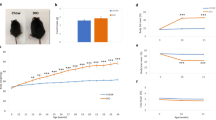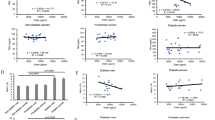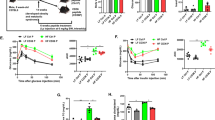Abstract
Objectives:
To test the potential efficacy of recombinant macrophage inhibitory cytokine-1 (MIC-1/GDF15) as an obesity therapeutic.
Methods:
Male C57BL/6 J mice, either fed on normal chow or high-fat diet for 16 weeks to induce diet-induced obesity, were infused with either recombinant MIC-1/GDF15 or vehicle for 34 days by osmotic minipump. During the experimental period metabolic parameters were measured. Blood and tissue were collected for analysis of inflammatory markers.
Results:
MIC-1/GDF15 decreased food intake and body weight of high-fat-fed and chow-fed mice compared with their vehicle-treated control mice. MIC-1/GDF15 reduced body weight, accompanied by greater reduction in fat mass in high-fat-fed mice compared to its effect on chow-fed mice. Further, whilst MIC-1/GDF15-treated chow-fed mice lost lean as well as fat mass, MIC-1/GDF15-treated high-fat-fed mice lost fat mass alone. This reduction in body weight and adiposity was due largely to reduced food intake, but MIC-1/GDF15-treated high-fat-fed mice also displayed increased energy expenditure that may be due to increased thermogenesis. MIC-1/GDF15-treated high-fat-fed mice also had higher circulating level of adiponectin and lower tissue expression, and circulating levels of leptin and inflammatory mediators associated with insulin resistance. Peripheral insulin and glucose intolerance were improved in both MIC-1/GDF15-treated high-fat-fed and chow-fed mice compared to that of their vehicle-treated control mice.
Conclusions:
MIC-1/GDF15 is highly effective in reducing adiposity and correcting the metabolic dysfunction of mice with high-fat fed. These studies suggest that MIC-1/GDF15 may be a candidate anti-obesity therapeutic.
This is a preview of subscription content, access via your institution
Access options
Subscribe to this journal
Receive 12 print issues and online access
$259.00 per year
only $21.58 per issue
Buy this article
- Purchase on Springer Link
- Instant access to full article PDF
Prices may be subject to local taxes which are calculated during checkout






Similar content being viewed by others
References
Johnen H, Lin S, Kuffner T, Brown DA, Tsai VW, Bauskin AR et al. Tumor-induced anorexia and weight loss are mediated by the TGF-beta superfamily cytokine MIC-1. Nat Med 2007; 13: 1333–1340.
Macia L, Tsai VW, Nguyen AD, Johnen H, Kuffner T, Shi YC et al. Macrophage inhibitory cytokine 1 (MIC-1/GDF15) decreases food intake, body weight and improves glucose tolerance in mice on normal & obesogenic diets. PLoS One 2012; 7: e34868.
Tsai VW, Husaini Y, Manandhar R, Lee-Ng KK, Zhang HP, Harriott K et al. Anorexia/cachexia of chronic diseases: a role for the TGF-beta family cytokine MIC-1/GDF15. J Cachexia Sarcopenia Muscle 2012; 3: 239–243.
Tsai VW, Lin S, Brown DA, Salis A, Breit SN . Anorexia-cachexia and obesity treatment may be two sides of the same coin: role of the TGF-b superfamily cytokine MIC-1/GDF15. Int J Obes (Lond) 2016; 40: 193–197.
Tsai VW, Manandhar R, Jorgensen SB, Lee-Ng KK, Zhang HP, Marquis CP et al. The anorectic actions of the TGFbeta cytokine MIC-1/GDF15 require an intact brainstem area postrema and nucleus of the solitary tract. PLoS ONE 2014; 9: e100370.
Breit SN, Johnen H, Cook AD, Tsai VW, Mohammad MG, Kuffner T et al. The TGF-beta superfamily cytokine, MIC-1/GDF15: a pleotrophic cytokine with roles in inflammation, cancer and metabolism. Growth Factors 2011; 29: 187–195.
Tanno T, Noel P, Miller JL . Growth differentiation factor 15 in erythroid health and disease. Curr Opin Hematol 2010; 17: 184–190.
Kempf T, Wollert KC . Growth-differentiation factor-15 in heart failure. Heart Fail Clin 2009; 5: 537–547.
Bauskin AR, Brown DA, Kuffner T, Johnen H, Luo XW, Hunter M et al. Role of macrophage inhibitory cytokine-1 in tumorigenesis and diagnosis of cancer. Cancer Res 2006; 66: 4983–4986.
Welsh JB, Sapinoso LM, Kern SG, Brown DA, Liu T, Bauskin AR et al. Large-scale delineation of secreted protein biomarkers overexpressed in cancer tissue and serum. Proc Natl Acad Sci USA 2003; 100: 3410–3415.
Stephan C, Xu C, Brown DA, Breit SN, Michael A, Nakamura T et al. Three new serum markers for prostate cancer detection within a percent free PSA-based artificial neural network. Prostate 2006; 66: 651–659.
Rasiah KK, Kench JG, Gardiner-Garden M, Biankin AV, Golovsky D, Brenner PC et al. Aberrant neuropeptide Y and macrophage inhibitory cytokine-1 expression are early events in prostate cancer development and are associated with poor prognosis. Cancer Epidemiology Biomarkers Prev 2006; 15: 711–716.
Koopmann J, Rosenzweig CN, Zhang Z, Canto MI, Brown DA, Hunter M et al. Serum markers in patients with resectable pancreatic adenocarcinoma: macrophage inhibitory cytokine 1 versus CA19-9. Clin Cancer Res 2006; 12: 442–446.
Koopmann J, Buckhaults P, Brown DA, Zahurak ML, Sato N, Fukushima N et al. Serum macrophage inhibitory cytokine 1 as a marker of pancreatic and other periampullary cancers. Clin Cancer Res 2004; 10: 2386–2392.
Brown DA, Ward RL, Buckhaults P, Liu T, Romans KE, Hawkins NJ et al. MIC-1 serum level and genotype: associations with progress and prognosis of colorectal carcinoma. Clin Cancer Res 2003; 9: 2642–2650.
Brown DA, Stephan C, Ward RL, Law M, Hunter M, Bauskin AR et al. Measurement of serum levels of macrophage inhibitory cytokine 1 combined with prostate-specific antigen improves prostate cancer diagnosis. Clin Cancer Res 2006; 12: 89–96.
Brown DA, Lindmark F, Stattin P, Balter K, Adami HO, Zheng SL et al. Macrophage inhibitory cytokine 1: a new prognostic marker in prostate cancer. Clinical Cancer Res 2009; 15: 6658–6664.
Selander KS, Brown DA, Sequeiros GB, Hunter M, Desmond R, Parpala T et al. Serum macrophage inhibitory cytokine-1 concentrations correlate with the presence of prostate cancer bone metastases. Cancer Epidemiol Biomarkers Prev 2007; 16: 532–537.
Lajer M, Jorsal A, Tarnow L, Parving HH, Rossing P . Plasma growth differentiation factor-15 independently predicts all-cause and cardiovascular mortality as well as deterioration of kidney function in type 1 diabetic patients with nephropathy. Diabetes Care 2010; 33: 1567–1572.
Kempf T, Eden M, Strelau J, Naguib M, Willenbockel C, Tongers J et al. The transforming growth factor-beta superfamily member growth-differentiation factor-15 protects the heart from ischemia/reperfusion injury. Circ Res 2006; 98: 351–360.
Dostalova I, Roubicek T, Bartlova M, Mraz M, Lacinova Z, Haluzikova D et al. Increased serum concentrations of macrophage inhibitory cytokine-1 in patients with obesity and type 2 diabetes mellitus: the influence of very low calorie diet. Eur J Endocrinol 2009; 161: 397–404.
Brown DA, Moore J, Johnen H, Smeets TJ, Bauskin AR, Kuffner T et al. Serum macrophage inhibitory cytokine 1 in rheumatoid arthritis: a potential marker of erosive joint destruction. Arthritis Rheum 2007; 56: 753–764.
Brown DA, Breit SN, Buring J, Fairlie WD, Bauskin AR, Liu T et al. Concentration in plasma of macrophage inhibitory cytokine-1 and risk of cardiovascular events in women: a nested case-control study. Lancet 2002; 359: 2159–2163.
Breit SN, Carrero JJ, Tsai VW, Yagoutifam N, Luo W, Kuffner T et al. Macrophage inhibitory cytokine-1 (MIC-1/GDF15) and mortality in end-stage renal disease. Nephrol Dial Transplant 2012; 27: 70–75.
Kempf T, Guba-Quint A, Torgerson J, Magnone MC, Haefliger C, Bobadilla M et al. Growth differentiation factor 15 predicts future insulin resistance and impaired glucose control in obese nondiabetic individuals: results from the XENDOS trial. Eur J Endocrinol 2012; 167: 671–678.
Mazagova M, Buikema H, van Buiten A, Duin M, Goris M, Sandovici M et al. Genetic deletion of growth differentiation factor 15 augments renal damage in both type 1 and type 2 models of diabetes. Am J Physiol Renal Physiol 2013; 305: F1249–F1264.
Hellemons ME, Mazagova M, Gansevoort RT, Henning RH, de Zeeuw D, Bakker SJ et al. Growth-differentiation factor 15 predicts worsening of albuminuria in patients with type 2 diabetes. Diabetes Care 2012; 35: 2340–2346.
Wiklund FE, Bennet AM, Magnusson PK, Eriksson UK, Lindmark F, Wu L et al. Macrophage inhibitory cytokine-1 (MIC-1/GDF15): a new marker of all-cause mortality. Aging Cell 2010; 9: 1057–1064.
Wang X, Chrysovergis K, Kosak J, Kissling G, Streicker M, Moser G et al. hNAG-1 increases lifespan by regulating energy metabolism and insulin/IGF-1/mTOR signaling. Aging 2014; 6: 690–704.
Tsai VW, Macia L, Johnen H, Kuffner T, Manadhar R, Jorgensen SB et al. TGF-b superfamily cytokine MIC-1/GDF15 is a physiological appetite and body weight regulator. PLoS One 2013; 8: e55174.
Wang X, Chrysovergis K, Kosak J, Eling TE . Lower NLRP3 inflammasome activity in NAG-1 transgenic mice is linked to a resistance to obesity and increased insulin sensitivity. Obesity 2014; 22: 1256–1263.
Chrysovergis K, Wang X, Kosak J, Lee SH, Kim JS, Foley JF et al. NAG-1/GDF-15 prevents obesity by increasing thermogenesis, lipolysis and oxidative metabolism. Int J Obes (Lond) 2014; 38: 1555–1564.
Bauskin AR, Brown DA, Junankar S, Rasiah KK, Eggleton S, Hunter M et al. The propeptide mediates formation of stromal stores of PROMIC-1: role in determining prostate cancer outcome. Cancer Res 2005; 65: 2330–2336.
Kleiner DE, Brunt EM, Van Natta M, Behling C, Contos MJ, Cummings OW et al. Design and validation of a histological scoring system for nonalcoholic fatty liver disease. Hepatology 2005; 41: 1313–1321.
Wang CY, Liao JK . A mouse model of diet-induced obesity and insulin resistance. Methods Mol Biol 2012; 821: 421–433.
Liu Y, Turdi S, Park T, Morris NJ, Deshaies Y, Xu A et al. Adiponectin corrects high-fat diet-induced disturbances in muscle metabolomic profile and whole-body glucose homeostasis. Diabetes 2013; 62: 743–752.
Luo N, Liu J, Chung BH, Yang Q, Klein RL, Garvey WT et al. Macrophage adiponectin expression improves insulin sensitivity and protects against inflammation and atherosclerosis. Diabetes 2010; 59: 791–799.
Permana PA, Menge C, Reaven PD . Macrophage-secreted factors induce adipocyte inflammation and insulin resistance. Biochem Biophys Res Commun 2006; 341: 507–514.
Toyoda T, Kamei Y, Kato H, Sugita S, Takeya M, Suganami T et al. Effect of peroxisome proliferator-activated receptor-alpha ligands in the interaction between adipocytes and macrophages in obese adipose tissue. Obesity 2008; 16: 1199–1207.
Xu H, Barnes GT, Yang Q, Tan G, Yang D, Chou CJ et al. Chronic inflammation in fat plays a crucial role in the development of obesity-related insulin resistance. J Clin Invest 2003; 112: 1821–1830.
Makki K, Froguel P, Wolowczuk I . Adipose tissue in obesity-related inflammation and insulin resistance: cells, cytokines, and chemokines. ISRN Inflamm 2013; 2013: 139239.
Kim JM, Kosak JP, Kim JK, Kissling G, Germolec DR, Zeldin DC et al. NAG-1/GDF15 transgenic mouse has less white adipose tissue and a reduced inflammatory response. Mediators Inflamm 2013; 2013: 641851.
Johnen H, Kuffner T, Brown DA, Wu BJ, Stocker R, Breit SN . Increased expression of the TGF-b superfamily cytokine MIC-1/GDF15 protects ApoE(-/-) mice from the development of atherosclerosis. Cardiovasc Pathol 2012; 21: 499–505.
Adela R, Banerjee SK . GDF-15 as a target and biomarker for diabetes and cardiovascular diseases: a translational prospective. J Diabetes Res 2015; 2015: 490842.
Carstensen M, Herder C, Brunner EJ, Strassburger K, Tabak AG, Roden M et al. Macrophage inhibitory cytokine-1 is increased in individuals before type 2 diabetes diagnosis but is not an independent predictor of type 2 diabetes: the Whitehall II study. Eur J Endocrinol 2010; 162: 913–917.
Feldmann HM, Golozoubova V, Cannon B, Nedergaard J . UCP1 ablation induces obesity and abolishes diet-induced thermogenesis in mice exempt from thermal stress by living at thermoneutrality. Cell Metab 2009; 9: 203–209.
Golozoubova V, Cannon B, Nedergaard J . UCP1 is essential for adaptive adrenergic nonshivering thermogenesis. Am J Physiol Endocrinol Metab 2006; 291: E350–E357.
Cannon B, Nedergaard J . Nonshivering thermogenesis and its adequate measurement in metabolic studies. J Exp Biol 2011; 214 (Pt 2): 242–253.
Acknowledgements
This project was supported in part by grants from the National Health and Medical Research Council (NHMRC) of Australia, Diabetes Australia and Thelma Greig Grant of the St Vincent’s Clinic Foundation. AS and DAB are recipients of NHMRC Career Development Awards or Fellowships.
Author contributions
SNB and VWT conceived the experiments. VWT, HPZ, RM, KKML-N, HL, CPM and YH generated the research data. VWT and SNB wrote the manuscript. VWT, SNB, AS and DAB contributed to discussion and reviewed and edited the manuscript.
Author information
Authors and Affiliations
Corresponding author
Ethics declarations
Competing interests
DAB and SNB are inventors on patents owned by St Vincent’s Hospital that pertain to the clinical use of MIC-1/GDF15. The remaining authors declare no conflict of interest.
Additional information
Supplementary Information accompanies this paper on International Journal of Obesity website
Supplementary information
Rights and permissions
About this article
Cite this article
Tsai, V., Zhang, H., Manandhar, R. et al. Treatment with the TGF-b superfamily cytokine MIC-1/GDF15 reduces the adiposity and corrects the metabolic dysfunction of mice with diet-induced obesity. Int J Obes 42, 561–571 (2018). https://doi.org/10.1038/ijo.2017.258
Received:
Revised:
Accepted:
Published:
Issue Date:
DOI: https://doi.org/10.1038/ijo.2017.258
This article is cited by
-
Significant increase of serum extracellular vesicle-packaged growth differentiation factor 15 in type 2 diabetes mellitus: a cross-sectional study
European Journal of Medical Research (2023)
-
Circulating GDF15 concentrations in girls with low birth weight: effects of prolonged metformin treatment
Pediatric Research (2023)
-
Novel Insights into the Physiology of Nutrient Sensing and Gut-Brain Communication in Surgical and Experimental Obesity Therapy
Obesity Surgery (2023)
-
Body composition and lung cancer-associated cachexia in TRACERx
Nature Medicine (2023)
-
Signaling pathways in obesity: mechanisms and therapeutic interventions
Signal Transduction and Targeted Therapy (2022)



